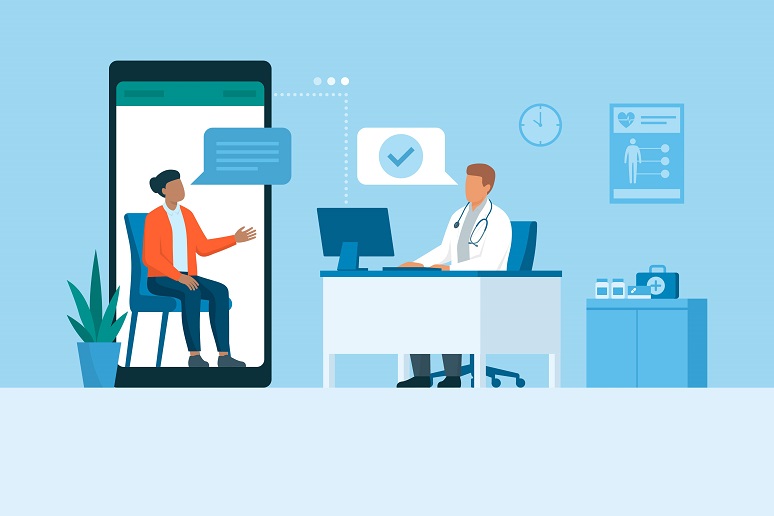Does your healthcare organization have a digital front door strategy for your robust telehealth offerings? In 2022, it needs one. A healthcare digital front door engages patients at all entry points in their healthcare journey through frictionless digital experiences: patients may begin their journey with your organization by researching care options and providers, then schedule appointments, and access telehealth services, all from their smart device or through a quick internet search. These digital experiences may replace traditionally manual or in-person services, or they may simply supplement human interactions by providing services at your patient's convenience.
Once your organization has standardized their physician search and scheduling workflows to support a digital provider look-up tool, you can begin digitizing existing manual processes – touchless registrations, digital form completion, and real-time insurance eligibility and benefit information – to connect patients to their chosen provider with ease. This is the moment of truth to engage patients in choosing you for their healthcare needs.
Healthcare is driven by choice, and consumers prioritize the ease and convenience of intuitive digital experiences. Each of these digital experiences is an opportunity to differentiate your organization's patient experience from competitors. Before the COVID-19 pandemic trends were towards robust and seamless digital options at every touchpoint in the healthcare journey. The pandemic accelerated this trend necessitating telehealth services. These telehealth services must prioritize accessibility, personalization, and convenience.
Gone are the days when patients are willing to accept delays to healthcare services through traditional contact center scheduling and in-person care. Developing a telehealth strategy that makes it easy to navigate, schedule with, and conduct virtual visits from a smart device fills the gaps for services and allow patients to access healthcare from their own homes.
These virtual visits offer real-time patient-provider interaction through a telehealth platform that increases office efficiency while also improving access to care for patients. Virtual visits are ideal for monitoring and treating ongoing health conditions that do not require physical examinations. This serves to both lower the barriers for patients by providing access to this care from the comfort of their own home and freeing organizational resources such as exam rooms and rooming staff for services that are best suited for in-person care. Your organization can leverage this for better access to services requiring in-person human contact for care.
There are two key considerations when developing your telehealth strategy. The first is selecting the right telehealth platform which is not like typical videoconference but rather the infrastructure and technology required for medical use. The platform must be private, secure, HIPAA-compliant, and provide high-quality video and audio to facilitate virtual medical consultations. The second consideration is a solid virtual visit policy providing personalization to the patient and better connects lower-acuity patients with the right provider quickly. Using both of these in conjunction with a traditional electronic health records platform (EHR) will offer maximum flexibility for providers, clinicians and patients.
Many EHR applications offer a telehealth platform integrated with their patient portal. Patient portals such as EPIC’s MyChart offer scheduling, registration, and telehealth within a single familiar app for existing patients. An integrated patient portal provides current patients and clinicians with a familiar look and feel and allows an easy transition to a hybrid model of care. Telehealth may begin with patients scheduling virtual care through their patient portal, completing virtual registration, and entering a virtual waiting room.
Many EHR applications also offer on-demand virtual visits and on-the-fly text-initiated telehealth directly out the EHR to increase flexibility and access. This simple integration is an ideal way to offer customized solutions for organizations with an existing strong digital front door and high patient portal activations and engagement. Simply adding a virtual option among existing in-person scheduling options supports organic growth in the area of virtual care.
Third-party platforms like Healthgrades and Zocdoc allow an opportunity for new patient scheduling and on-demand virtual care. These are smart device apps and browser-based solutions, which healthcare consumers use to research providers and schedule care directly from the provider profile. For patients who self-refer and don’t have an existing relationship with your organization, these app’s “Find a Provider” functions connect consumer with providers that meet their current healthcare needs. A database-style website such as Healthgrades lists providers with the National Provider Identifier Registry, and a quick google search may land a consumer on your provider’s profile. Adding a direct scheduling option makes a seamless entry to your digital front door without requiring the patient to find your organization's webpage. These platforms may be configured and integrated into existing EHRs and offer integrated telehealth capabilities.
For healthcare organizations without EHR integrated telehealth platforms and new patient targeted on-demand programs such as Healthgrades and Zocdoc, adding a telehealth dialer provides a cost-effective and easy to implement way to provide telehealth with little to no customization. HIPAA-compliant dialers such as Doximity and UpDoc can send video chat links via text from a smart device. Using the app, providers simply initiate video chat or secure messaging via text. Providers have the flexibility to use any smartphone, tablet, or laptop and eliminate virtual waiting rooms and digital registration processes. Patients are not required to download apps or initiate any scheduling or registration processes, making access to care feel as familiar as using FaceTime.
Consumer-driven healthcare trends indicate virtual visit options are here for the foreseeable future. Incorporating telehealth with an overall digital front door strategy customized for your organization's unique brand provides the flexibility of care for both existing patients who are familiar with your providers and in-person services, as well as providing a point of entry for new patients seeking virtual care directly. Whichever platform your healthcare organization leverages for virtual visits, a solid digital presence for provider search, appointment scheduling, and easy access to virtual care is vital to stand out in the healthcare market.
Frances is writing on behalf of the SCTC, a premier professional organization for independent consultants. SCTC consultant members are leaders in the industry, able to provide best of breed professional services in a wide array of technologies. Every consultant member commits annually to a strict Code of Ethics, ensuring they work for the client benefit only and do not receive financial compensation from vendors and service providers.











